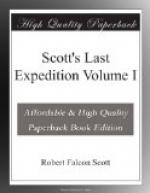I have observed several floes with an entirely new type of surface. They are covered with scales, each scale consisting of a number of little flaky ice sheets superimposed, and all ‘dipping’ at the same angle. It suggests to me a surface with sastrugi and layers of fine dust on which the snow has taken hold.
We are within 5 miles of Cape Royds and ought to get there.
Wednesday, January 4, P.M..—This work is full of surprises.
At 6 A.M. we came through the last of the Strait pack some three miles north of Cape Royds. We steered for the Cape, fully expecting to find the edge of the pack ice ranging westward from it. To our astonishment we ran on past the Cape with clear water or thin sludge ice on all sides of us. Past Cape Royds, past Cape Barne, past the glacier on its south side, and finally round and past Inaccessible Island, a good 2 miles south of Cape Royds. ’The Cape itself was cut off from the south.’ We could have gone farther, but the last sludge ice seemed to be increasing in thickness, and there was no wintering spot to aim for but Cape Armitage. [5] ’I have never seen the ice of the Sound in such a condition or the land so free from snow. Taking these facts in conjunction with the exceptional warmth of the air, I came to the conclusion that it had been an exceptionally warm summer. At this point it was evident that we had a considerable choice of wintering spots. We could have gone to either of the small islands, to the mainland, the Glacier Tongue, or pretty well anywhere except Hut Point. My main wish was to choose a place that would not be easily cut off from the Barrier, and my eye fell on a cape which we used to call the Skuary a little behind us. It was separated from old Discovery quarters by two deep bays on either side of the Glacier Tongue, and I thought that these bays would remain frozen until late in the season, and that when they froze over again the ice would soon become firm.’ I called a council and put these propositions. To push on to the Glacier Tongue and winter there; to push west to the ‘tombstone’ ice and to make our way to an inviting spot to the northward of the cape we used to call ‘the Skuary.’ I favoured the latter course, and on discussion we found it obviously the best, so we turned back close around Inaccessible Island and steered for the fast ice off the Cape at full speed. After piercing a small fringe of thin ice at the edge of the fast floe the ship’s stem struck heavily on hard bay ice about a mile and a half from the shore. Here was a road to the Cape and a solid wharf on which to land our stores. We made fast with ice anchors. Wilson, Evans, and I went to the Cape, which I had now rechristened Cape Evans in honour of our excellent second in command. A glance at the land showed, as we expected, ideal spots for our wintering station. The rock of the Cape consists mainly of volcanic agglomerate with olivine kenyte; it is much weathered and the




